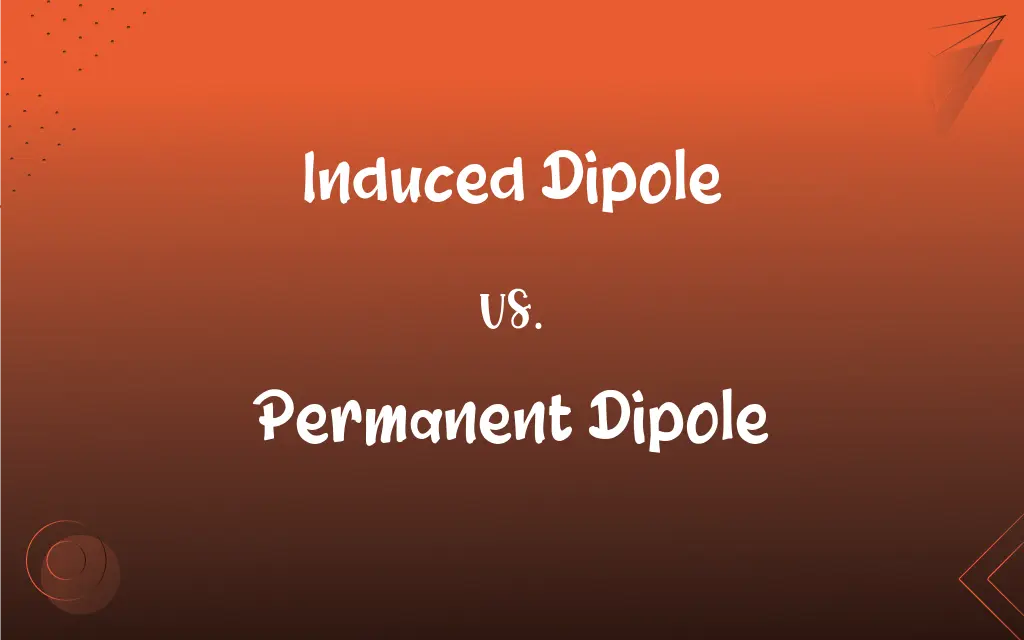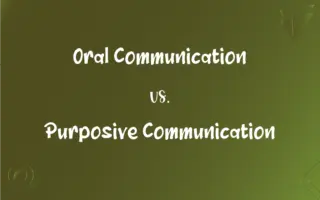Induced Dipole vs. Permanent Dipole: What's the Difference?
Edited by Aimie Carlson || By Janet White || Published on March 2, 2024
Induced dipoles are temporary and result from external influences, while permanent dipoles have a constant separation of charge.

Key Differences
Induced dipoles occur when the electron distribution in an atom or molecule is temporarily distorted by an external electric field or by the proximity of a polar molecule. This temporary shift creates a momentary dipole. Permanent dipoles, on the other hand, are a characteristic of molecules where atoms have different electronegativity, leading to a constant uneven distribution of electronic charge and a continuous separation of charge within the molecule.
In the case of induced dipoles, the effect is fleeting, and the dipole disappears when the external influence is removed. These dipoles play a crucial role in the properties of non-polar substances under the influence of polar molecules or electric fields. Permanent dipoles are inherent to the molecular structure of polar molecules, resulting in permanent attractions and repulsions that significantly influence the physical properties and interactions of these molecules.
The interaction strength between molecules with induced dipoles is generally weaker compared to those with permanent dipoles. Induced dipole interactions, such as London dispersion forces, are significant in non-polar molecules and contribute to their boiling and melting points. Permanent dipole interactions, such as hydrogen bonds and dipole-dipole interactions, are stronger and more critical in determining the behavior of polar substances.
Induced dipoles allow non-polar molecules to interact with polar molecules to some extent, facilitating solubility and other forms of interaction that would otherwise be minimal. Permanent dipoles, by their nature, create stronger and more directional interactions, leading to higher boiling points, melting points, and solubility in polar solvents for substances with permanent dipoles.
Both induced and permanent dipoles are fundamental to understanding molecular interactions, their differences highlight the diverse ways molecules can exhibit polarity and interact with each other. The temporary nature of induced dipoles contrasts with the fixed polarity of permanent dipoles, illustrating the complexity of chemical behaviors.
ADVERTISEMENT
Comparison Chart
Nature of Polarity
Temporary, caused by external influence
Inherent, due to unequal electronegativity
Duration
Exists only in presence of an external field
Permanent, independent of external conditions
Interaction Strength
Generally weaker than permanent dipole interactions
Stronger, due to constant charge separation
Influence on Physical Properties
Affects properties under specific conditions
Consistently influences boiling/melting points, solubility
Role in Molecular Interactions
Facilitates weak interactions in non-polar molecules
Leads to stronger, directional interactions in polar molecules
ADVERTISEMENT
Induced Dipole and Permanent Dipole Definitions
Induced Dipole
A temporary dipole formed by external electrical fields.
An induced dipole was observed in the helium atom when it was near a charged particle.
Permanent Dipole
Results from atoms with different electronegativities.
The HF molecule's permanent dipole is due to the high electronegativity difference between H and F.
Induced Dipole
Weakens as the inducing field or molecule moves away.
The induced dipole in argon vanished as the ion was removed.
Permanent Dipole
Influences molecular orientation in electric fields.
The permanent dipole in HCl aligns it in an electric field.
Induced Dipole
Results from the momentary distortion of electron clouds.
The induced dipole in the nitrogen molecule increased its solubility in water.
Permanent Dipole
A constant separation of charge in a molecule.
The water molecule has a permanent dipole due to its bent shape.
Induced Dipole
Enhances solubility of non-polar substances in polar solvents.
The induced dipole in methane molecules allowed them to dissolve slightly in water.
Permanent Dipole
Critical for hydrogen bonding in water.
The permanent dipole in water molecules enables hydrogen bonding, making ice less dense than liquid water.
Induced Dipole
Facilitates interactions between non-polar molecules.
Induced dipoles explain the attraction between two oxygen molecules.
Permanent Dipole
Leads to strong intermolecular forces.
Permanent dipoles in ammonia molecules contribute to its high boiling point.
FAQs
How do permanent dipoles affect physical properties?
Permanent dipoles significantly influence boiling points, melting points, and solubility due to their constant charge separation.
What causes a permanent dipole?
A permanent dipole is caused by a constant uneven distribution of electrons due to atoms within a molecule having different electronegativities.
What creates an induced dipole?
External electric fields or the proximity of polar molecules temporarily distort the electron cloud, creating an induced dipole.
Are induced dipoles temporary?
Yes, induced dipoles are temporary and exist only while under the influence of an external field or molecule.
Can an induced dipole occur in a polar molecule?
Yes, even polar molecules can exhibit induced dipoles in response to external electric fields or interactions with other molecules.
How are permanent dipoles measured?
Permanent dipoles are measured by their dipole moment, which quantifies the charge separation and molecular shape.
Do all molecules have induced dipoles?
In theory, all molecules can have induced dipoles under the right external conditions.
Can induced dipoles occur in ionic compounds?
Ionic compounds primarily exhibit ionic bonds, but their ions can induce dipoles in nearby non-polar molecules.
How do induced dipoles affect solubility?
Induced dipoles can increase the solubility of non-polar substances in polar solvents by temporarily creating a dipole.
What role do permanent dipoles play in chemical reactions?
Permanent dipoles can influence the reactivity and orientation of molecules in chemical reactions.
How do induced dipoles interact with each other?
Induced dipoles interact through weak London dispersion forces, affecting the properties of non-polar substances.
Can an induced dipole lead to a permanent dipole?
No, an induced dipole is always temporary and cannot become a permanent dipole.
What determines the strength of a permanent dipole?
The difference in electronegativity between atoms and the molecular geometry determine the strength of a permanent dipole.
Can a non-polar molecule have a permanent dipole?
No, non-polar molecules lack a permanent dipole due to their symmetrical shape and uniform electronegativity distribution.
Do permanent dipoles change in strength?
No, the strength of permanent dipoles is constant and inherent to the molecular structure.
How do permanent dipoles affect molecular interactions?
Permanent dipoles lead to stronger, more directional intermolecular forces, such as dipole-dipole interactions and hydrogen bonding.
How do environmental conditions affect induced dipoles?
Environmental conditions such as temperature and electric field strength can influence the occurrence and strength of induced dipoles.
Do induced dipoles contribute to boiling points?
Yes, induced dipoles contribute to the boiling points of non-polar substances through London dispersion forces.
What is the significance of induced dipoles in gases?
Induced dipoles explain why even noble gases, which are non-polar, can liquefy under certain conditions.
Are permanent dipoles always polar?
Yes, molecules with permanent dipoles are considered polar because of their inherent charge separation.
About Author
Written by
Janet WhiteJanet White has been an esteemed writer and blogger for Difference Wiki. Holding a Master's degree in Science and Medical Journalism from the prestigious Boston University, she has consistently demonstrated her expertise and passion for her field. When she's not immersed in her work, Janet relishes her time exercising, delving into a good book, and cherishing moments with friends and family.
Edited by
Aimie CarlsonAimie Carlson, holding a master's degree in English literature, is a fervent English language enthusiast. She lends her writing talents to Difference Wiki, a prominent website that specializes in comparisons, offering readers insightful analyses that both captivate and inform.































































